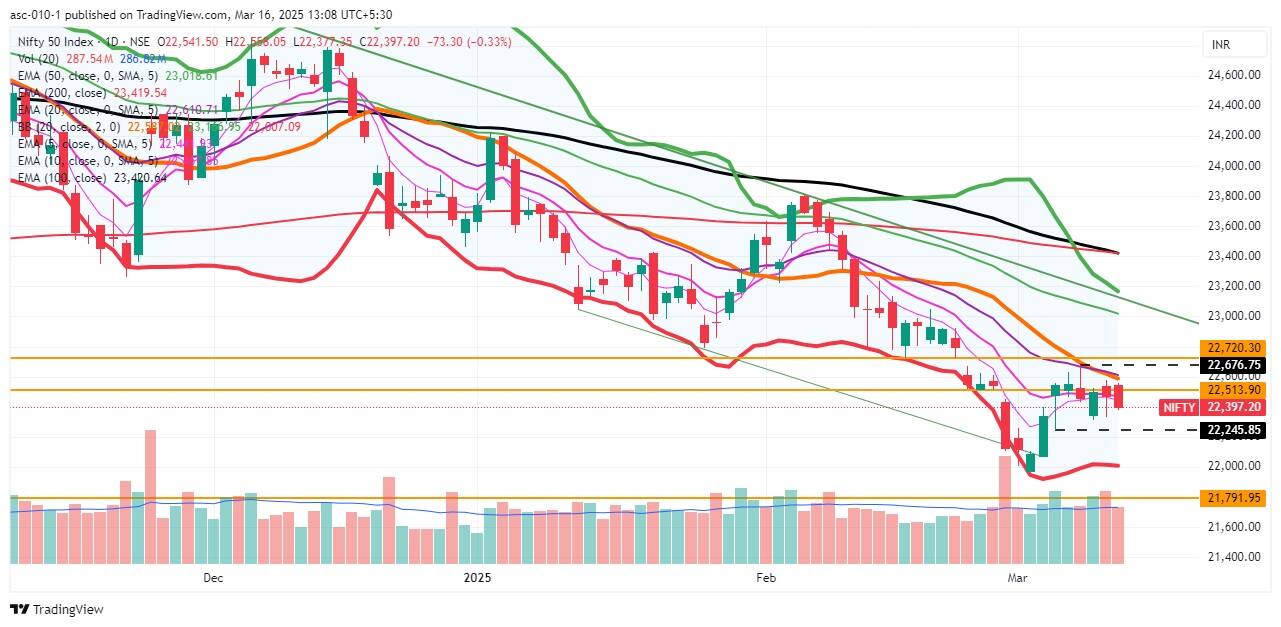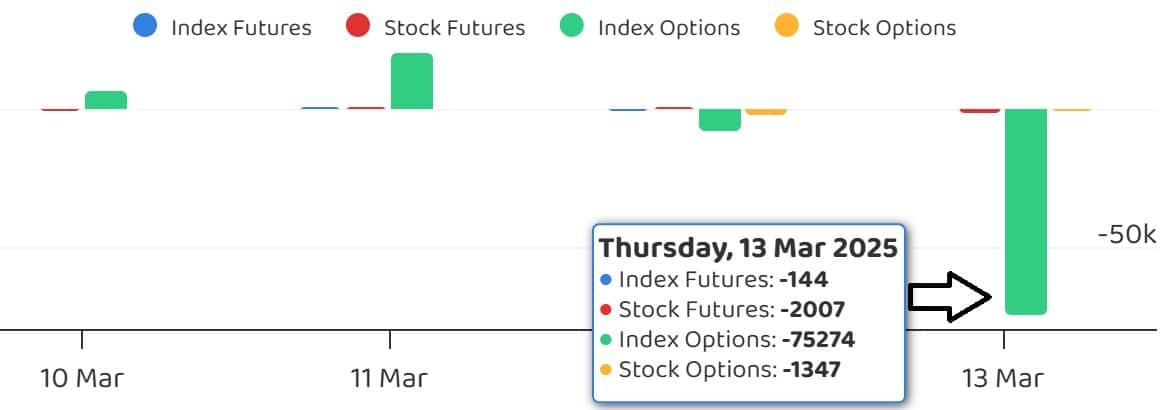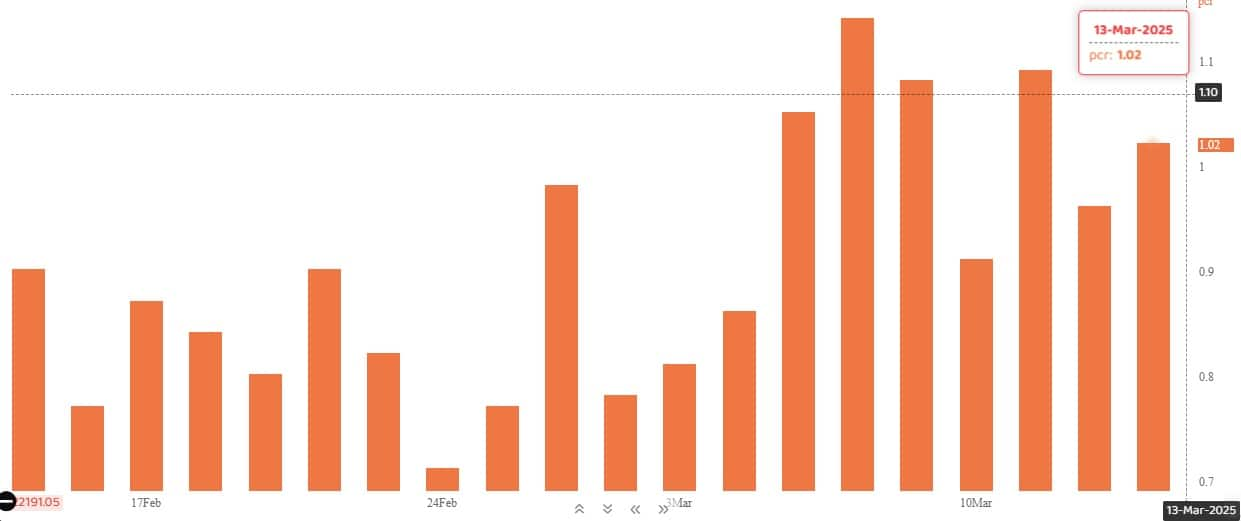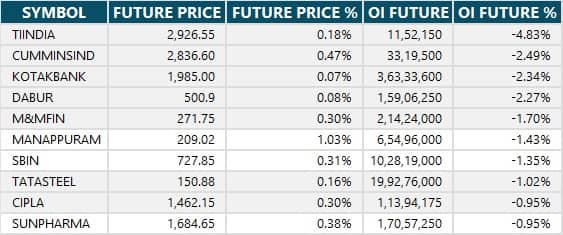



The market remained under pressure for another session, with the Nifty 50 failing to sustain above the 5 and 10-day EMAs and closing down by a third of a percent amid rangebound trading on March 13. With the fall in India VIX to its lowest closing level of the current year, the Nifty 50 may see some rebound in the upcoming session. However, sustainability will be key to watch. Until the index gives a decisive and sustainable close above the 22,650-22,700 zone on the higher side (which coincides with the 20-week EMA and the bearish gap of February 24), a major rally is unlikely. On the lower side, the 22,300-22,250 range is expected to act as immediate support, according to experts.

Here are 15 data points we have collated to help you spot profitable trades:
1) Key Levels For The Nifty 50 (22,397)
Resistance based on pivot points: 22,513, 22,556, and 22,625
Support based on pivot points: 22,375, 22,332, and 22,263
Special Formation: The Nifty 50 formed a bearish candlestick pattern on the daily charts with average volumes, and traded still below all key moving averages as well as in the lower band of Bollinger Bands, which is a negative sign. The lower highs-lower lows formation can't be negated until the index gives a decisive close above the 22,700 mark.
2) Key Levels For The Bank Nifty (48,060)
Resistance based on pivot points: 48,272, 48,354, and 48,486
Support based on pivot points: 48,007, 47,926, and 47,793
Resistance based on Fibonacci retracement: 49,290, 50,282
Support based on Fibonacci retracement: 47,872, 46,078
Special Formation: The Bank Nifty closed flat and reported a bearish candlestick pattern with a minor upper shadow on the daily timeframe. The index still traded below all key moving averages (5, 10, 20, 50, 100, and 200-day EMAs) and below the midline of Bollinger Bands, which is a negative sign. If the index manages to give a strong and sustainable close above 48,800, the lower highs-lower lows formation may be negated.

According to the weekly options data, the 23,000 strike holds the maximum Call open interest (with 51.83 lakh contracts). This level can act as a key resistance for the Nifty in the short term. It was followed by the 22,500 strike (50.4 lakh contracts) and the 22,700 strike (49.39 lakh contracts).
Maximum Call writing was observed at the 22,700 strike, which saw an addition of 36.69 lakh contracts, followed by the 23,000 and 22,400 strikes, which added 25.01 lakh and 21.9 lakh contracts, respectively. There was hardly any Call unwinding seen in the 21,500-23,350 strike band.

On the Put side, the maximum Put open interest was seen at the 22,000 strike (with 93 lakh contracts), which can act as a key support level for the Nifty. It was followed by the 21,500 strike (58.06 lakh contracts) and the 22,400 strike (32.72 lakh contracts).
The maximum Put writing was placed at the 22,000 strike, which saw an addition of 72.26 lakh contracts, followed by the 21,500 and 22,400 strikes, which added 29.84 lakh and 14.46 lakh contracts, respectively. There was hardly any Put unwinding seen in the 21,500-23,350 strike band.

5) Bank Nifty Call Options Data
According to the monthly options data, the maximum Call open interest was seen at the 49,000 strike, with 19.32 lakh contracts. This can act as a key resistance level for the index in the short term. It was followed by the 50,000 strike (15.38 lakh contracts) and the 48,500 strike (12.43 lakh contracts).
Maximum Call writing was visible at the 50,100 strike (with the addition of 1.91 lakh contracts), followed by the 48,000 strike (1.87 lakh contracts) and the 48,200 strike (1.32 lakh contracts). The maximum Call unwinding was seen at the 47,700 strike, which shed 4,260 contracts, followed by the 47,900 and 47,600 strikes, which shed 2,400 and 1,920 contracts, respectively.

6) Bank Nifty Put Options Data
On the Put side, the 48,000 strike holds the maximum Put open interest (with 15.34 lakh contracts), which can act as a key support level for the index. This was followed by the 47,000 strike (11.68 lakh contracts) and the 47,500 strike (8.86 lakh contracts).
The maximum Put writing was observed at the 48,000 strike (which added 87,660 contracts), followed by the 48,200 strike (69,930 contracts) and the 48,400 strike (60,510 contracts). The maximum Put unwinding was seen at the 47,400 strike, which shed 72,330 contracts, followed by the 47,800 and 48,500 strikes which shed 24,780 and 22,770 contracts, respectively.


The Nifty Put-Call ratio (PCR), which indicates the mood of the market, increased to 1.02 on March 13, against 0.96 in the previous session.
The increasing PCR, or being higher than 0.7 or surpassing 1, means traders are selling more Put options than Call options, which generally indicates the firming up of a bullish sentiment in the market. If the ratio falls below 0.7 or moves towards 0.5, then it indicates selling in Calls is higher than selling in Puts, reflecting a bearish mood in the market.

9) India VIX
The India VIX, the fear factor, extended its downtrend for another session and sustained below the 14 mark at 13.28, down 3.01 percent on Thursday, making the trend more favourable for bulls. In fact, the VIX ended at its lowest closing level since December 27, 2024.

A long build-up was seen in 24 stocks. An increase in open interest (OI) and price indicates a build-up of long positions.

11) Long Unwinding (69 Stocks)
69 stocks saw a decline in open interest (OI) along with a fall in price, indicating long unwinding.

12) Short Build-up (105 Stocks)
105 stocks saw an increase in OI along with a fall in price, indicating a build-up of short positions.

13) Short-Covering (22 Stocks)
22 stocks saw short-covering, meaning a decrease in OI, along with a price increase.

Here are the stocks that saw a high share of delivery trades. A high share of delivery reflects investing (as opposed to trading) interest in a stock.

Securities banned under the F&O segment include companies where derivative contracts cross 95 percent of the market-wide position limit.
Stocks added to F&O ban:
Stocks retained in F&O ban: BSE, IndusInd Bank, Hindustan Copper, Manappuram Finance, SAIL
Stocks removed from F&O ban: Nil
Disclaimer: The views and investment tips expressed by experts on Moneycontrol are their own and not those of the website or its management. Moneycontrol advises users to check with certified experts before taking any investment decisions.
Disclosure: Moneycontrol is a part of the Network18 group. Network18 is controlled by Independent Media Trust, of which Reliance Industries is the sole beneficiary.
Discover the latest Business News, Sensex, and Nifty updates. Obtain Personal Finance insights, tax queries, and expert opinions on Moneycontrol or download the Moneycontrol App to stay updated!
Find the best of Al News in one place, specially curated for you every weekend.
Stay on top of the latest tech trends and biggest startup news.